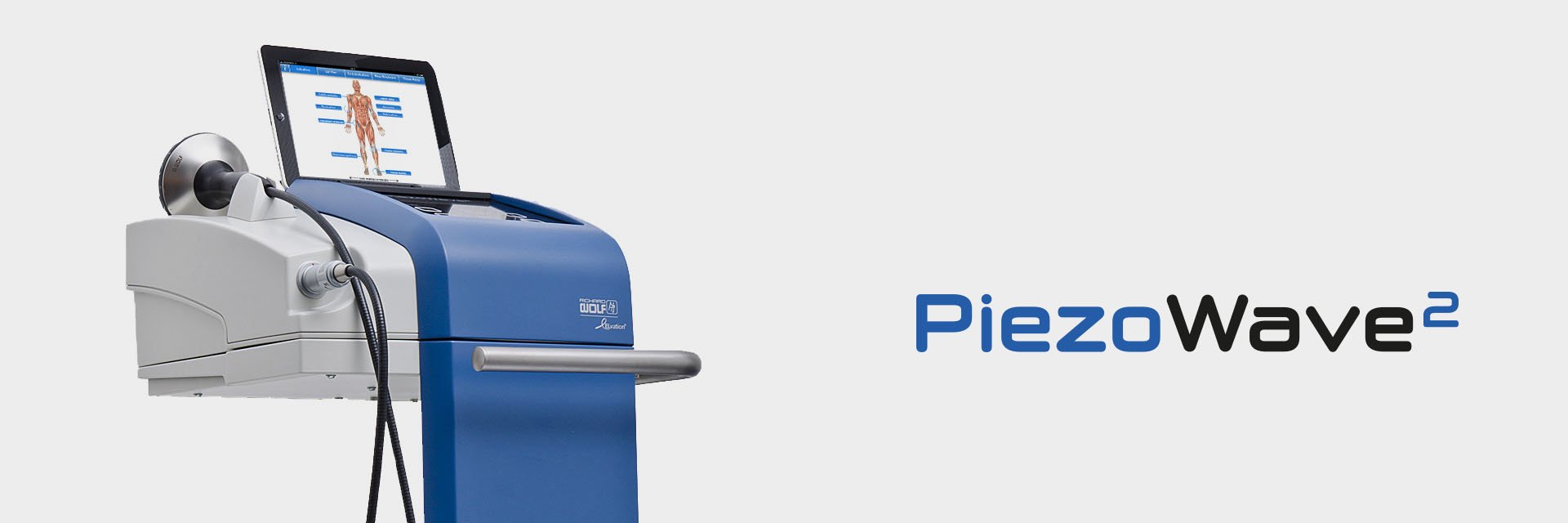Targeted, Non-Invasive Pain Relief
Myofascial Acoustic Compression Therapy (MyACT)
Piezo Wave machine, a state-of-the-art device used for effective, non-invasive therapy to promote healing and pain relief.
The doctor is performing PiezoWave therapy on a patient's knee, using sound waves to provide deep tissue relief and promote healing.
What is Piezo Wave Therapy?
The PiezoWave is a unique, highly effective medical technology that is virtually painless, non-invasive and reduces the need for drugs or surgery.
The acoustic waves generated by the PiezoWave therapy sources meet at a point deep within the soft tissue to produce an intense, extremely short duration pressure wave. This focused acoustic compression force is translated to the surrounding tissue like an extremely precise therapeutic deep tissue massage.
The results of the mechanical stimulus delivered by MyACT can lead to increased circulation and pain relief – key components in the healing process.
Advantages of Myofascial Acoustic Compression Therapy
Locates and alleviates musculoskeletal pain
Improves mobility
Non-Invasive
Reduced Pain Medications
Outpatient treatment
Short therapy time of approx. 10-20 min
PiezoWave Therapy Can Successfully Treat
Plantar Fasciitis
Neck Pain
Carpal Tunnel
Elbow Pain
Shoulder Pain
Hip Pain
Scar Tissue Treatment
And many more..
PiezoWave Therapy Treats Pain Resulting From
Trigger Points
Myofascial Dysfunction
Tendinopathy
Soft Tissue Strains
Repetitive Stress
Injuries
FAQs
If you have anymore questions, please feel free to contact us!
-
A typical PiezoWave2 treatment lasts between 10 and 20 minutes. Usually, 1-2 treatments per week are performed over an average of 6 weeks. A total of 3-5 treatments may be necessary before lasting improvement is achieved. For acute pain, a single session is often successful
-
Yes, Piezo Wave therapy is completely safe and involves no risks. It is a much safer alternative to surgery and injections. This procedure does not require anesthesia, and you can immediately return to your daily activities after your session, with no downtime, pain, or discomfort. It will not worsen any injury and is designed to provide effective pain relief and promote healing without causing harm.
-
Piezo Wave therapy is effective for treating both acute and chronic pain in muscles and joints. It is commonly used to relieve conditions such as plantar fasciitis, tendonitis, sprains, strains, and various other soft tissue injuries.
-
We will first identify the treatment site or sites and then apply a thin coat of coupling gel. Next, we will start the treatment at a very low output setting and gradually increase the power to a level that you help define (based on your pain level) and that is best suited for your condition.
As we move the Piezo wand around the treatment area, you may feel a deep, dull ache over the area of concern. We will ask you to report when you feel this ache and will adjust the output of the device to the appropriate level for your treatment. The treatment typically lasts about 10 to 20 minutes, depending on the area being treated. After the treatment, we recommend drinking plenty of water to keep your muscles hydrated for a faster and more effective recovery
-
Piezo Wave therapy generally has minimal side effects. Some people may experience mild discomfort or a dull ache in the treated area for a short time. In rare cases, there could be temporary redness. Overall, it is considered a safe treatment with few adverse effects.
-
Piezo Wave therapy and ultrasound therapy both aim to relieve pain and promote healing, but they work differently.
Piezo Wave therapy uses high-energy acoustic waves to target deep tissues and stimulate healing processes, often providing faster and more effective results for chronic conditions. It can penetrate precise depths beneath your skin, ranging from 0.5 mm to 3 cm, which is much deeper than standard ultrasound.
Ultrasound therapy, on the other hand, uses lower-frequency sound waves to generate heat and improve blood flow in the affected area. It is typically used for more superficial conditions and may take longer to produce noticeable results compared to Piezo Wave therapy.
Piezo Wave therapy is also useful in identifying trigger points—discrete, focal, and hyperirritable spots in the taut bands of muscle. These trigger points can generate pain both locally and in referred pain patterns and may accompany chronic musculoskeletal disorders.



